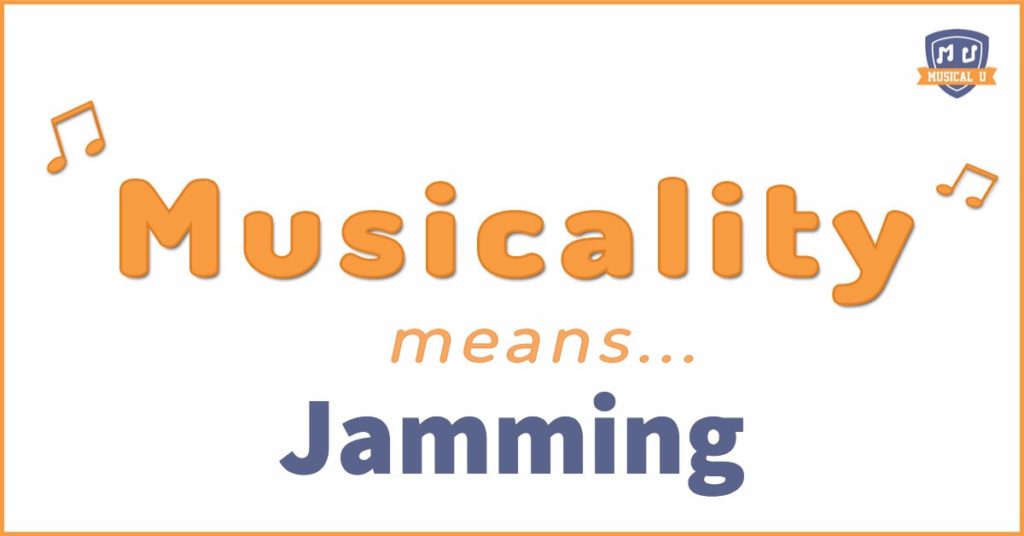In this series of posts we explore musicality: what it means to be “musical”.
Want to see a musician smile? Invite them to a jam session. No other musical experience truly allows a performer to “let loose” and explore unknown realms of audio nirvana. Awe-inspiring jamming takes great musicality. The electric guitarist’s fingers fly at a dizzying pace, the drummer seems like she’s in a mad trance as limbs race in crazed groove, and the bass player’s syncopated rhythms drive the band on a hypnotically inspired moment of sheer musical bliss. When musicians jam, the magic of sound is palpable, dancing to the beat like a perfectly in-sync machine.
But a jam session is more than a host of musicians playing random melodies and rhythm. Top notch musicality is key to a great jam session, but what is actually involved in a jam session? And why is jamming valuable?
Why you should Jam
When you are jamming with other musicians, you have a chance to work on important musicianship skills like improvisation, rhythm, harmony, melody, and playing by ear. Each of these critical elements works on your overall musical skills and lets you work on creativity and performance.
Improvisation skills can seem difficult to a beginning musician. In improvisation, you are creating and performing at the same time, often creating melodies, rhythms, and harmonies that work with the other band members. This musical skill requires you to have a good ear. When you jam there is some musical freedom, but often the harmonies and rhythms need to work well with the other components like pieces of a jigsaw puzzle. Throw in a wrong chord or a too-funky rhythm, and the entire groove can fizzle and burn.
For example, you might watch a jazz ensemble in concert. The bass player lays down a steady progression, the drummer keeps steady time, and the horns or keyboard jumps in with a melody. Then the soloing section comes in, a kind of planned jam session, and that’s the moment that the audience experiences sheer melodic genius. The sax player might explode in a hurried mass of notes or maybe the pianist wows the audience with his impeccable harmonic taste and virtuosity. The band may make space for the drummer, bringing on a wall of rhythmic sound. This is a controlled jam session, in live performance, for the audience’s benefit, but honestly, for the performers, too, who have been dying to show off some serious improvisation skills.
How can I learn how to Jam?
Learning how to jam with other musicians doesn’t require a degree in rocket science. The most obvious answer to this question is to jam with other musicians as often as possible. The more you play, the more you work on your musicality. But it is also very important to work on your overall musicianship by learning ear training, music theory, and good rhythm. Your personal practice will show when you are in a live situation with other musicians.
Develop your instrumental and vocal skills to a high level. You need to know your instrument inside and out, understanding what works and doesn’t work and what sounds best (and worst). For example, you might excel in a certain range on your saxophone, need some work on complicated electric guitar licks, or need to work on polyrhythms when you jam on the drums. Each instrument and vocal part is unique, and by working on your overall musicality you will be able to learn the skills that will help you jam better with other musicians.
Always challenge your musicality by increasing the difficulty of the music you practice. Playing everyday is key to developing your jam. Be sure to use tools like a metronome and tuner as you practice. There are many apps available today that can help a musician stay in time and in tune. Take advantage of these as you spend time each day practicing.
How Musical U helps you learn to Jam
 At Musical U you will find a dedicated and engaging musical community that will help you on your musical journey. With helpful staff members and in-depth training modules that work on musical skills like improvisation and ear training, you will develop your musicianship to an overall high level that will help you when you jam with your band. And if you have any questions, a quick post on our Musical U message board will yield a host of helpful tips and tricks from seasoned professionals and fellow musicians that are walking the same path that you are.
At Musical U you will find a dedicated and engaging musical community that will help you on your musical journey. With helpful staff members and in-depth training modules that work on musical skills like improvisation and ear training, you will develop your musicianship to an overall high level that will help you when you jam with your band. And if you have any questions, a quick post on our Musical U message board will yield a host of helpful tips and tricks from seasoned professionals and fellow musicians that are walking the same path that you are.
An exhaustive series of training modules covers melodies, chord progressions, singing, and rhythm with fun audio examples and an effective skill-based approach to learning. Additional modules with helpful performance tips and ways to build confidence will give you the self-assurance that you need to enter a jam session and rock on.
Any time there is a musical skill that you need extra help on for jam sessions you can dive instrument-first into comprehensive musical training that will teach you how to play common chord progressions in major and minor, duple and triplet rhythms, complicated world music rhythms, syncopation, and jazz chords.
Musicality means Jamming!
Lose the butterflies next time you are jamming with your friends. Work on your musicianship, practicing everyday and developing musicality in music theory, rhythm, melody, harmony, and improvisation.
Learning how to jam successfully on your instrument with fellow bandmates, using your ear training skills, benefits and refines your performance skills. Train yourself to improvise and be a jam guru and you’ll find that what you have learned will translate to your overall musicianship. And next time you sit in on a jam session, you will ooze with groove!








Trackbacks/Pingbacks